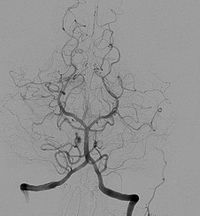
Photo from wikipedia
Objectives: The aim of this research was to summarize the clinical and prognostic features of the skull-base meningiomas with extracranial extensions, and enhance the management of skull-base communicative meningiomas. Methods… Click to show full abstract
Objectives: The aim of this research was to summarize the clinical and prognostic features of the skull-base meningiomas with extracranial extensions, and enhance the management of skull-base communicative meningiomas. Methods We retrospectively studied the medical records and analyzed the follow-up information of 53 patients who have done surgery for skull-base meningiomas with extracranial extensions in West China Hospital of Sichuan University from 2009 to 2020. Results The incidence of skull-base meningiomas with extracranial extensions was 0.74%. The average diagnosis age was 45.9 years, with a 1:3.1 men to women ratio. WHO grade I was seen in 84.9% of patients, and higher grades were found in 15.1%. Heterogeneous enhancement, high bone invasion rate, high incidence of peritumoral edema, and high dural tail sign rate were typical imaging features. Routine craniotomy and endoscopic endonasal approach were adopted, and gross total resection was performed in 62.3% of cases with 20.8% postoperative complication rates. The average follow-up time was 61.5 months, with a recurrence rate of 34.9%. By survival analysis, the extent of resection (p = 0.009) and the histological grade (p = 0.007) were significantly related to the prognosis. Adjuvant radiotherapy proved beneficial in patients with subtotal resection (p = 0.010) and high-grade meningiomas (p = 0.018). Conclusions Skull-base meningiomas with extracranial extensions were sporadic. According to the tumor location and communication way showed by the preoperative imaging, routine craniotomy or endoscopic endonasal approach with a reasonable skull-base repair strategy could be adopted to achieve the maximum tumor resection. Maximized resection, adjuvant radiotherapy, and low histological grade indicate a better prognosis.
Journal Title: Frontiers in Neurology
Year Published: 2022
Link to full text (if available)
Share on Social Media: Sign Up to like & get
recommendations!